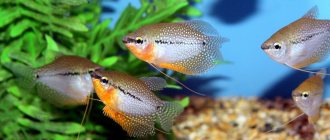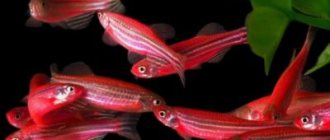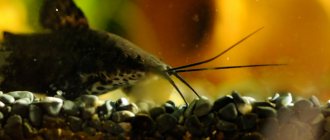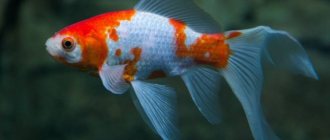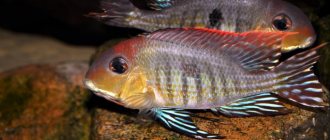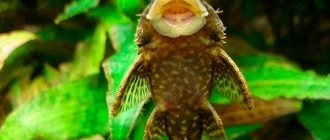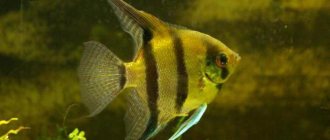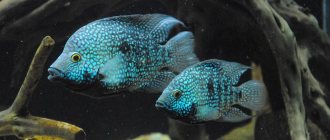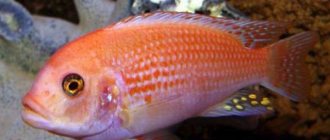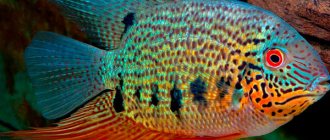What does a gourami look like?
This is a charming fish with an elongated body, slightly compressed from the sides. Its dimensions are small; in aquariums you can rarely find an individual larger than 10 cm; in nature, some species can be 20-25 cm long.
The dorsal and pelvic fins stretch along the entire body, expanding slightly towards the end. The structure of the pectoral fins, which gave the Latin name to the genus - Trichogaster (“thread from the belly”) or Trichopodus (“thread-legged”), is unique: instead of the usual fins, gourami have long thin threads growing in front, which are a tactile organ.
Variety of colors
Varieties of gourami are distinguished by colorful colors and poetic names: marbled gourami, kissing, grumbling, honey, brooding and many others. But if we take a scientifically strict approach, then 4 species directly belong to trichogaster gourami:
- pearl gourami – light silver with a lilac sparkle, strewn with light spots - “pearls”, yellowish back, bluish fins, along the midline the body is divided in half by a dark dotted stripe;
pearl gourami
- moon gourami – about 12 cm long, bluish color with a steely sheen and bright orange eyes, bright, very long orange or yellow breast threads;
- brown gourami – the largest, can reach 15-17 cm, brown-silver, with a stripe along the body in the form of black spots, with transverse stripes of a darker shade than the background;
- spotted gourami – the most colorful, due to crossing, various combinations of yellow, blue and white are possible, spots all over the body of various shapes, transverse and longitudinal stripes are barely visible.
Some color morphs of spotted gourami received their own names - blue, gold and others.
Description and varieties
Gourami are labyrinthine freshwater fish that have taken root in artificial habitats. Here are some of their natural habitats in the world:
- South Vietnam;
- Indonesia;
- Thailand;
- Malay Peninsula.
The name "labyrinthine" was given to this species because it can use ordinary atmospheric air to survive.
The peculiarity of such fish is the presence of a special organ or, as it is called, a “labyrinth apparatus”, which evolved through evolution in the inhabitants of very polluted water bodies.
When the water is cloudy for a very long time, fish swim to the surface and “swallow” air with this particular apparatus, thanks to which they can continue to live in dirty pools.
Did you know? The aquarium, as we see it today and use it in interior decoration, was invented by an English scientist in 1841.
They are valued due to the fact that they differ from others in their unpretentiousness and rather calm character, as well as a variety of species with original colors and fin shapes.
This fish has an upper fin, or dorsal fin as it is also called, which is quite small, but still always follows the texture and pattern of the body. The anal fin, or ventral one, located below, is most often equal in size to the length of the body of the fish itself.
It consists of many ordered threads. They are an important organ of the gourami. With their help, fish can sense over long distances, detect danger and navigate while moving.
When they swim, they feel everything under them using these strings. It is also impossible not to note the perfect mustache, which most often does not leave neighbors indifferent.
The fish can grow up to 12 centimeters in artificial habitat, but most have a body length of 3 to 8 centimeters. Gourami live for quite a long time.
A long-lived fish is known, whose age was 88 years. Of course, this is a very rare exception, but their fairly long lifespan is a big plus for aquarium enthusiasts.
You will also be interested to know how clown fish live.
Now let's introduce several of the most popular types of gourami aquarium fish, add photos with names and a brief description.
Let's start with, perhaps, the most beautiful and unusual type of gourami - pearl . The body of the fish is orange-red, with a dark stripe running along it, and small white pearl dots are scattered over almost the entire surface of the body.
This species is also unique because the fish make their own sound, which becomes especially expressive when the female lays eggs. The sounds are produced by the movement of the fins.
In males, at this time, the red tint on the body becomes even brighter and seems to be blazing with fire. An amazing fact is that this species has memory and can recognize its owner.
Did you know? In the wild, pearl gouramis are listed in the Red Book, since every year the atmosphere and waters become polluted, and they are threatened with extinction. For example, the population has completely disappeared in Thailand, where the largest number of pearl fish were previously born.
This species lives up to 8 years and grows up to 9 centimeters in length. It is quite easy to distinguish between male and female pearl gourami.
The female has a weaker color and small fins, while the male stands out for his brightness and large fins.
The mesmerizing marbled gourami is somewhat similar to the blue one. Their body is colored a metallic blue, but the first species also has an interesting pattern of darker shades.
The female and male representing the marbled gourami are somewhat different in body shape and color.
The female sex is more rounded and has a lighter color, while the male sex is elongated and dark. The body grows up to 10 centimeters in length, but the female is usually always smaller.
The blue look shines very beautifully , reflecting the rays of light. On the monochromatic blue body there are sometimes individual dark spots, which makes the fish unique.
A rather funny species is the kissing gourami . Their mouths are slightly open, and when the fish begin to communicate, it seems that they are kissing.
Why gouramis do this has not yet been explained. They have a gray body with a gray-green tint and pink color, with transparent fins and small scales.
This species is quite large: it grows up to 15 centimeters. Therefore, they require special conditions of detention - the aquarium should have an average volume of 200 liters.
The only thing that distinguishes them from other species is their more hot-tempered and aggressive nature, which often complicates the process of creating an aquarium with individuals of different species.
Did you know? The kissing gourami grows up to 30 centimeters in nature in the waters of Thailand and Indonesia. Therefore, this species is quite often used as food.
Honey gourami is a very interesting species. The male's body is decorated with a dark brown stripe on the bottom in the abdominal area.
The female is somewhat lighter and without stripes. The colors of this species can range from orange and yellow to bright red.
Another species is golden , very popular among aquarium lovers. It will stand out with a unique golden tint.
How to distinguish a male from a female
It is quite easy to distinguish a boy from a girl gourami: there are several characteristic features.
| Male | Female |
| Larger | Smaller body |
| Slimmer look | Round shape |
| Bright color | Somewhat muted colors |
| The dorsal fin is large and elongated | Dorsal fin small, rounded |
| Pectoral fins orange | Pectoral fins yellow |
| During arousal, the breast changes color and becomes brighter | No changes observed |
Maintenance and care
They are unpretentious and tenacious, do not require any special conditions, and are undemanding to the cleanliness and aeration of water. The only thing that is necessary for gourami and without which they can die is access to atmospheric air.
It is advisable that the aquarium have a lid that provides a warm and moist air layer - the labyrinthine organ of the fish is very delicate, it can be injured by temperature differences.
The water in the aquarium should be warm, about 25-27 degrees; cold water is destructive for southern residents. Let there be a lot of aquatic plants, including a couple of thickets where the gourami can hide. Natural driftwood is good for the design and health of fish - they release beneficial humic substances.
When choosing an aquarium, focus on the number of fish and their adult sizes. For a couple of small gouramis, a 20-liter container is also suitable, but for the brown family it is better to take an aquarium of 80-100 liters. You can place several females with one male, but not vice versa - otherwise aggression is possible.
Caring for a gourami’s home is simple:
- do a weekly water change of 20-25% of the total volume;
- occasionally clean the walls of the aquarium;
- From time to time, clean the soil using the siphon method;
- Don’t forget to rinse the internal filter on time.
Features of reproduction
It is with reproduction that owners may have problems, because this process requires attention. Interestingly, pearl mussels make sounds during spawning, and also change their color beyond recognition - they become bright and beautiful as never before.
How to distinguish a female from a male
To increase the number of pearl gourami in your aquarium, it is enough to buy several males and females. The main thing here is not to confuse. The male sex of a fish can be determined by its size and fins. If the fish is large, bright and has a sharp upper fin, it is a male.
Females have rounded fins on their back. During spawning, you can also observe differences: in males, the throat and belly become bright red.
Reproduction
Males engage in peculiar fights for female fish - it looks as if they are kissing. Therefore, pairs are separated during mating. Their temporary home should be densely planted with algae - the future father will use it to make a nest.
The peculiarity of these fish is that they build so-called foam nests for their offspring, so there should be enough building materials. Breeding pearl gourami is an interesting process. The male invites the female to the finished nest, where he inseminates the eggs, which he squeezes out of the female. He has to constantly catch them from the surface, since they are lighter than water and float. In total, one spawning can produce about 2000 eggs.
These fish are characterized by eating their offspring, and the male may begin to pursue the mother. So it’s better to return her to her old house. And the man will remain to guard the offspring until the fry swim.
For babies, ciliates and microworms are suitable as food. At first, they need aeration of the water, then the labyrinthine apparatus will be completely formed, and the fish will be able to breathe above the water.
Pearl gourami is suitable for both professional aquarists and beginners. They are pleasant to watch and will be interesting to children. And with proper maintenance, they will live a long life.
pets2.me
If you decide to breed gourami, you need to have information on many issues. To organize the reproduction of these fish, it is very important to know: how to distinguish a female from a male gourami?
By observing the behavior of fish in an aquarium, over time one acquires the skill of determining their gender differences. Clear external characteristics that distinguish males and females are formed in gouramis at the age of approximately 6 months (sometimes a little later, depending on the species). By this time, the fish become sexually mature and ready to reproduce.
It is important to keep in mind that the name “gurami” is a collective one and unites aquarium fish of several genera from the macropod family, which are slightly different in appearance. And the criteria by which you can see how male and female gourami differ are different for each genus.
Fin shape and size
The most popular gourami are fish from the genus Trichogaster. What difference is primarily noticeable in the appearance of female and male gouramis of this genus?
Pay attention to the dorsal fin; in the male it is long and reaches almost to the tail. The second feature of the dorsal fin: it is pointed at the end, as if slightly elongated. If you see such a dorsal fin structure on a fish, be sure that it is a male.
Female gouramis of the genus Nitebrae have a neater dorsal fin. It is also quite tall, but is not elongated at the end and does not reach the caudal fin.
To understand how to distinguish a female from a male thread-bearing gourami, compare the size of fish with different shapes of dorsal fins: elongated and rounded. Males are usually larger than females, unlike viviparous fish such as guppies, in which females are larger and males are smaller.
rybkivse.ru
Gourami breeding
Even a beginner can handle it. You don’t even have to have a separate container for spawning: a general aquarium is also suitable if it has floating plants and there is no strong current. For reproduction, it is better to slightly increase the water temperature - to 25-27 degrees. A couple of “newlyweds” need to be given plenty of live food for 1-2 weeks.
Gourami have very interesting mating games - males change color and spread their fins. The father builds the nest and takes care of it - he creates a foam ball from air bubbles and his saliva. When finished, he drives the female under the nest and fertilizes the eggs. He will carefully deliver the eggs that float to the top to the nest. After this, the female will want to hide in a shelter, and if this is a separate aquarium, it is better to put her away immediately.
When the larvae hatch, they will spend about 3 more days in the nest, and then, as fry, they will begin to swim, and here it is more advisable to separate the father from them. It practically does not eat during the entire spawning period, so it is better to protect the offspring. It is best to feed the “kids” with ciliates and special food.
After a month, the fry will develop a labyrinthine apparatus.
Compatibility with other fish
Typically, gourami are peaceful towards other species and live quietly with them in the same aquarium. But aggression is occasionally possible:
- if the size of the aquarium is not enough for comfortable living;
- if there are no or few places for shelter;
- while protecting the nest during spawning.
It has been noticed that gouramis more often fight with relatives or close relatives.
You should not house gourami and swordtails together, as well as Sumatran barbs - they tend to bite the gourami's whiskers. Do not put gourami in an aquarium with cichlids or goldfish.
What to feed the fry
The fry do not need food for another 3–4 days, feeding on the contents of the yolk sac. They will then require external feeding. Meals can be provided 5-6 times a day, the portions should be small.
Food for gourami fry can be as follows:
- Rotifer.
- Ciliates.
- Liquid food for fry.
- Hard-boiled egg yolk, pureed through cheesecloth.
After just a few weeks, the fish can be transplanted into a common aquarium, while adding protein-rich food to their diet - it will help the scales develop correctly and add brightness to the color.
